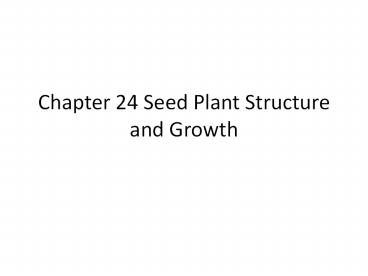Chapter 24 Seed Plant Structure and Growth - PowerPoint PPT Presentation
1 / 25
Title:
Chapter 24 Seed Plant Structure and Growth
Description:
Chapter 24 Seed Plant Structure and Growth PLANT TISSUES- Vascular plants have three tissue systems Dermal tissue forms the protective outer layer of a plant. – PowerPoint PPT presentation
Number of Views:329
Avg rating:3.0/5.0
Title: Chapter 24 Seed Plant Structure and Growth
1
Chapter 24 Seed Plant Structure and Growth
2
- PLANT TISSUES- Vascular plants have three tissue
systems - Dermal tissue forms the protective outer layer of
a plant. - Vascular tissue forms strands that conduct water,
minerals, and organic compounds throughout a
vascular plant. - Ground tissue makes up much of the inside of the
nonwoody parts of a plant, including roots,
stems, and leaves
3
- DERMAL TISSUE SYSTEM- Dermal tissue covers the
outside of a plants body. In the nonwoody parts
of a plant, dermal tissue forms a skin called
epidermis.
4
Tissue Systemand Its Functions Component Tissues Location of Tissue Systems
Dermal Tissue System protection prevention of water loss EpidermisPeriderm (in older stems and roots)
Ground Tissue System photosynthesis food storage regeneration support protection Parenchyma tissueCollenchyma tissueSclerenchyma tissue
Vascular Tissue System transport of water and minerals transport of food Xylem tissuePhloem tissue
5
- Extensions of the epidermal cells on root tips,
called root hairs, help increase water
absorption. - A waxy cuticle coats the epidermis of stems and
leaves. The cuticle protects the plant and
prevents water loss.
6
- Pores called stomata (singular, stoma) permit
plants to exchange oxygen and carbon dioxide. A
pair of specialized cells called guard cells
borders each stoma. Stomata open and close as
the guard cells change shape.
7
(No Transcript)
8
- In addition to its role in protection, dermal
tissue functions in gas exchange and in the
absorption of mineral nutrients
9
- VASCULAR TISSUE SYSTEM- Vascular plants have two
kinds of vascular tissue, called xylem and
phloem, that transport water, minerals, and
nutrients throughout the plant.
10
- Xylem is composed of thick-walled cells that
provide support and conduct water and mineral
nutrients from a plants roots through its stems
to its leaves. - Phloem is made up of cells that conduct sugars
and nutrients throughout a plants body.
11
- GROUND TISSUE SYSTEM- Ground tissue makes up much
of the inside of most nonwoody plants, where it
surrounds and supports vascular tissue.
12
- ROOTS- Most plants are anchored to the spot where
they grow by roots, which absorb water and
mineral nutrients. In many plants, roots also
function in the storage of organic nutrients,
such as sugar and starch
13
- Most monocots, such as grasses, have a highly
branched, fibrous root system. - Many dicots, such as dandelions and radishes,
have a large central root from which smaller
roots branch. This type of system is called a
taproot system.
14
- STEMS- Stems support the leaves and house the
vascular tissue, which transports substances
between the roots and the leaves.
15
- A plant with stems that are flexible and usually
green is called a herbaceous plant. The stems of
herbaceous plants contain bundles of xylem and
phloem called vascular bundles. The tissue at
the center of the stem of most vascular plants is
called the pith
16
- Woody stems, such as those of trees and shrubs,
are stiff and nongreen. The wood in the center
of a mature stem or tree trunk is called
heartwood. Sapwood, which lies outside the
heartwood, contains vessel elements that can
conduct water.
17
- LEAVES- Leaves are the primary photosynthetic
organs of plants.
18
- Most leaves have a flattened portion, the blade,
which is usually attached to a stem by a stalk,
called the petiole. - A cuticle coats the upper and lower epidermis
19
- Both xylem and phloem are found in the veins of a
leaf. Veins are extensions of vascular bundles
that run from the tips of roots to the edge of
leaves. - In leaves, the ground tissue is called mesophyll.
Mesophyll cells are packed with chloroplasts,
where photosynthesis occurs
20
- MERISTEMS- Plants grow by producing new cells in
regions of active cell division called meristems. - Growth that increases the length or height of a
plant is called primary growth. - Growth that increases the width of stems and
roots is called secondary growth.
21
- PRIMARY GROWTH- Primary growth makes a plants
stems and roots get longer without becoming
wider. - Apical meristems, which are located at the tips
of stems and roots, produce primary growth
through cell division. - The new cells produced by apical meristems
differentiate into the primary tissues of roots,
stems, and leaves. - Each branch of a stem and each branch of a root
has its own apical meristem that produces new
primary tissues as the branch grows.
22
- SECONDARY GROWTH- Lateral meristems are
responsible for increases in the width of stems
and roots. This increase is called secondary
growth. - Some of the undifferentiated cells that are left
behind as stems and roots lengthen and produce
lateral meristems. - The two lateral meristems responsible for
secondary growth are called the cork cambium and
the vascular cambium.
23
(No Transcript)
24
(No Transcript)
25
(No Transcript)































